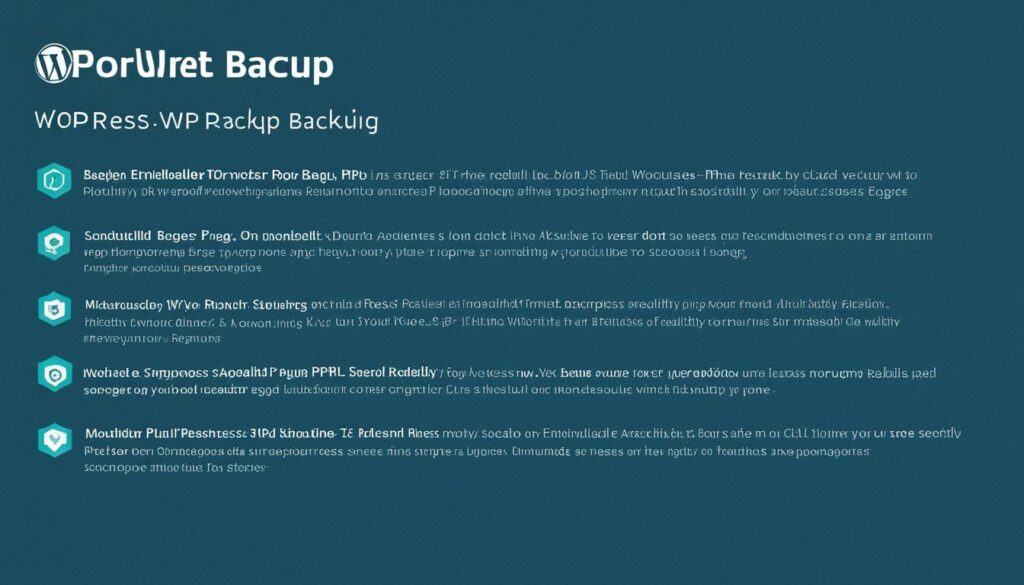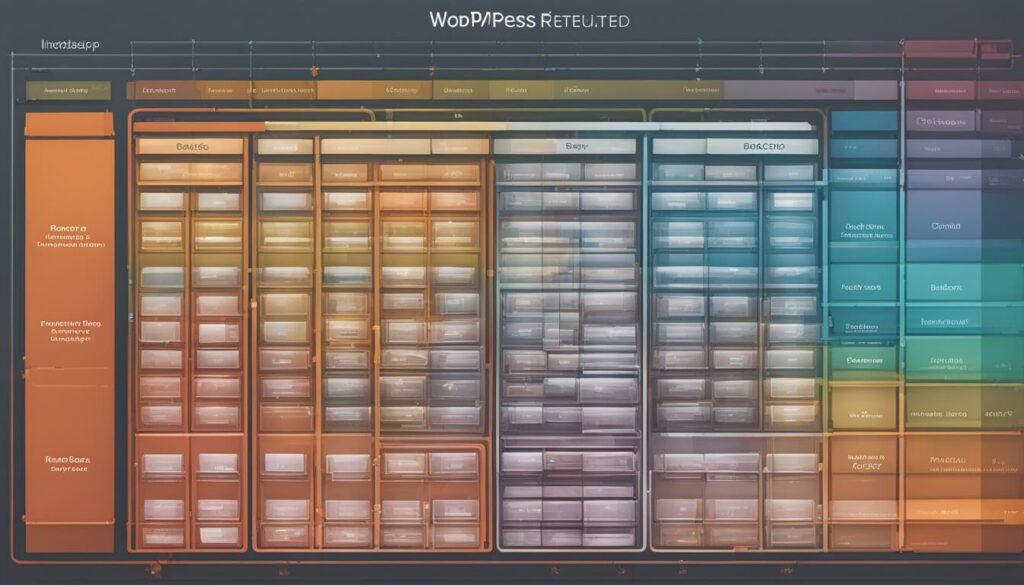Welcome to our quick start guide on creating reliable backups for your WordPress site. In this article, we will walk you through various methods and techniques for safeguarding your website data. By implementing a proper backup strategy, you can protect your site from security threats and human errors. Let’s get started!
Key Takeaways:
- WordPress backups are essential to protect your data from security threats and potential loss.
- There are multiple methods to backup your WordPress site, including using plugins, manual backups, and FTP clients.
- Regular backups ensure that you can easily restore your site to a previous version if needed.
- Consider using reliable backup plugins like Duplicator to simplify the backup process and schedule automated backups.
- Always store your backup files in a secure location and test the restore process regularly.
Why Backing up Your WordPress Site is Crucial
Backing up your WordPress site is of utmost importance to safeguard your valuable data. Whether it’s protecting your site from cyber attacks, server failures, or human errors, a robust backup strategy ensures that you can recover and restore your site smoothly.
Without a backup, your website runs the risk of losing crucial content, plugins, themes, and settings. With the increasing prevalence of cyber attacks and the potential for server failures, relying solely on your hosting provider’s backup may not be sufficient.
Creating regular backups gives you peace of mind and allows you to restore your site to a previous version if any unexpected issues arise. Let’s take a closer look at the key reasons why backing up your WordPress site is crucial:
Protection Against Cyber Attacks and Malware
Cyber attacks can wreak havoc on your WordPress site, compromising sensitive information, causing data breaches, and disrupting its functionality. Without a secure backup, recovering from such attacks can be challenging and time-consuming.
By regularly backing up your WordPress site, you establish a safety net that enables you to quickly restore your site to a pre-attack state. This prevents data loss and minimizes downtime, ensuring your website remains accessible to your visitors.
Safeguarding Against Server Failures
Your hosting provider’s servers can occasionally experience failures due to various reasons. These failures can result in website downtime and potential data loss if a recent backup is not available.
By creating regular backups of your WordPress site, you mitigate the risks associated with server failures. In case of any server issues, you can swiftly restore your site using the most recent backup, reducing the impact on your business and user experience.
Protection from Human Errors
Human errors, such as accidental deletions, misconfigurations, or plugin/theme conflicts, can be detrimental to your website’s functionality and content. Without a backup, rectifying these mistakes can be a time-consuming and costly process.
With regular backups in place, you can quickly revert to a previously functioning version of your site in the event of a human error, minimizing the impact on your website and reducing the time needed to resolve the issue.
Remember, data loss can occur at any time, so backing up your WordPress site is not a one-time task. Setting up automated backups and regularly testing the restore process ensures that you have the most up-to-date backup available when you need it.
Next, we will explore various methods for backing up your WordPress site, including using plugins, manual backups through cPanel, backing up databases, and using FTP clients. These methods provide flexibility and cater to different user preferences, ensuring that you can choose the best backup approach for your specific needs.
Method 1: Backup a WordPress Site Using a Plugin (Recommended)
One of the easiest ways to backup your WordPress site is by using a plugin, such as Duplicator. Duplicator is a popular WordPress backup plugin that offers a user-friendly interface and a range of features to ensure a smooth backup process. With Duplicator, you can not only create backups, but also migrate your site to a new hosting provider and schedule automated backups for added convenience.
Installing and configuring Duplicator is a straightforward process. Here’s a step-by-step guide to help you get started:
- Go to your WordPress dashboard and navigate to the Plugins section.
- Click on Add New and search for “Duplicator” in the search bar.
- Click on Install Now next to the Duplicator plugin.
- Once the installation is complete, click on Activate to activate the plugin.
- Once activated, you will find the Duplicator menu item on the left sidebar of your dashboard. Click on it to access the plugin’s settings.
- Follow the on-screen instructions to create a backup of your WordPress site. Duplicator will guide you through the process, allowing you to select the files and databases you want to include in the backup.
- After the backup is complete, Duplicator will provide you with a downloadable package containing all your site files and databases.
- It is recommended to store the backup file in a secure location, such as an external hard drive or cloud storage.
Using Duplicator, you can also schedule regular backups to ensure your site is always protected. Simply navigate to the Duplicator settings and configure the backup frequency and retention period according to your preferences. This way, you can automate the backup process and have peace of mind knowing that your WordPress site is being regularly backed up.
With its intuitive interface and comprehensive feature set, Duplicator is an excellent choice for backing up your WordPress site. Whether you want to create a one-time backup or schedule automated backups for added convenience, Duplicator provides a seamless backup solution that is suitable for all WordPress users. Start protecting your site today and enjoy the peace of mind that comes with having a reliable backup plugin like Duplicator.

Method 2: Manually Backup a WordPress Site Using cPanel
If you prefer to have more control over your backups, you can manually backup your WordPress site using the cPanel provided by your WordPress hosting service. This method allows you to compress your site files and download the backup to your computer, ensuring the safety of your valuable data.
To manually backup your WordPress site using cPanel, follow these steps:
Step 1: Access the cPanel
First, log in to your WordPress hosting account and navigate to the control panel, also known as cPanel.
Usually, you can access the cPanel by appending “/cpanel” to the end of your domain name (e.g., www.yourdomain.com/cpanel). If you’re not sure how to access the cPanel, contact your hosting provider for assistance.
Step 2: Locate the Backup Tools
Inside the cPanel, search for the “Backup” or “Backup Wizard” option. The exact location may vary depending on your hosting provider, but it’s generally found in the “Files” or “Advanced” section.
Step 3: Generate a Manual Backup
Once you’ve found the backup tools, select the option to create a manual backup. This will initiate the backup process for your WordPress site.
Depending on your hosting provider, you may have the option to select specific directories or files to include in the backup. Make sure to select all the necessary files related to your WordPress site to ensure a complete backup.
Step 4: Compress the Backup Files
After selecting the files, you’ll have the option to compress them into a single backup file. Compressing the files reduces their size and makes downloading and storing the backup more efficient.
Choose the compression format that your hosting provider supports, such as ZIP or TAR.GZ, and initiate the compression process.
Step 5: Download the Backup
Once the compression is complete, you can download the backup file to your computer. Select the option to download the backup and choose a location on your computer where you want to save it.
Be sure to store the backup file in a secure location, such as an external hard drive or cloud storage service, to ensure its safety.
Step 6: Verify the Backup
Before considering the backup process complete, it’s important to verify the backup file. Check that the size and contents of the backup file match the size and contents of your WordPress site.
Regularly test the restoration process using the backup file to ensure that you can successfully recover your site if needed.
Congratulations! You have successfully manually backed up your WordPress site using cPanel. Remember to repeat this process periodically to keep your backups up to date and ensure the security of your website’s valuable data.

Method 3: Manually Backup WordPress Databases
In addition to backing up your WordPress site files, it is important to also backup your WordPress databases. By manually backing up your WordPress databases using phpMyAdmin, a commonly used database management tool, you can ensure the safety and security of your website’s data. This method involves exporting the database as an SQL file and saving it to a secure location. In this section, we will guide you through the process of backing up and restoring your WordPress databases.
Backing Up WordPress Databases using phpMyAdmin
Step 1: Access phpMyAdmin
To begin, access your website’s phpMyAdmin interface. This can usually be done through your hosting provider’s control panel or by entering the URL “yourwebsite.com/phpmyadmin” in your web browser.
Step 2: Select the WordPress Database
Once in phpMyAdmin, locate the panel on the left side of the screen containing a list of databases. Select the database associated with your WordPress site by clicking on its name.
Step 3: Export the Database
In the database view, click on the “Export” tab located in the top menu. This will open the export options page.
Note: Make sure that all the tables in your WordPress database are selected for backup. The default selection should be sufficient, but double-check to ensure no tables are left out.
In the export options page, select the following:
| Option | Value |
|---|---|
| Export method | Quick – display only the minimal options |
| Format | SQL |
| SQL compatibility mode | None |
| Output | Save output to a file |
After selecting the appropriate options, click the “Go” button to initiate the export process. The database will be exported as an SQL file and downloaded to your device.
Restoring a WordPress Database Backup
Step 1: Access phpMyAdmin
To restore a WordPress database backup, access phpMyAdmin again using the same method as before.
Step 2: Create a New Database
Before restoring the backup, create a new database within phpMyAdmin. To do this, go to the main database view and click on the “New” button in the top menu. Enter a name for the new database and click “Create” to proceed.
Step 3: Import the Backup
With the new database selected, navigate to the “Import” tab in phpMyAdmin. Here, click the “Choose File” button and select the SQL file you previously exported as your backup. Click the “Go” button to import the backup into the new database.
Once the import process is complete, you have successfully restored your WordPress database backup. It is recommended to test your website thoroughly to ensure that everything is functioning properly.
Remember, regularly backing up your WordPress databases is crucial for protecting the integrity of your website’s data. By following the steps outlined in this section, you can secure your WordPress site and be prepared for any unforeseen circumstances.
Method 4: Manually Backup a WordPress Site Using FTP
Another manual backup method is using an FTP client, such as FileZilla, to backup your WordPress site. This method involves connecting to your site via FTP, selecting the files and folders you want to backup, and downloading them to your local computer. Follow the steps below to backup your WordPress site using FileZilla:
Step 1: Download and Install FileZilla
If you don’t have FileZilla installed on your computer, you can download it for free from the official FileZilla website. Choose the appropriate version for your operating system and follow the installation instructions.
Step 2: Connect to Your WordPress Site
Launch FileZilla and enter your FTP login credentials in the provided fields. The FTP host will usually be your domain name (e.g., ftp.yourdomain.com), and the username and password will be the same as your hosting account credentials. Click on the “Quickconnect” button to establish a connection with your site.
Step 3: Navigate to Your WordPress Site’s Directory
Once connected, you will see two panes in FileZilla. The left pane represents the files and folders on your local computer, while the right pane represents the files and folders on your WordPress site. Navigate to the directory where your WordPress site is installed on the right pane.
Step 4: Select the Files to Backup
On the right pane, select all the files and folders that you want to include in your backup. This typically includes your WordPress core files, themes, plugins, and any uploaded media. Right-click on the selected items and choose the “Download” option to initiate the backup process.
Step 5: Download the Backup
FileZilla will start downloading the selected files and folders to your local computer. The time it takes to complete the download will depend on the size of your site and your internet connection speed. Once the download is finished, you will have a local copy of your WordPress site as a backup.
It’s important to note that when using FileZilla to backup your WordPress site, you have full control over selecting the specific files and folders to include in your backup. This allows you to exclude unnecessary files or large media files that may not be crucial for restoring your site.
Remember to store your backup files in a secure location, such as an external hard drive or cloud storage service, to ensure their safety. Regularly create backup copies to keep your WordPress site data up-to-date and protected against any potential risks.

| Pros | Cons |
|---|---|
| Allows selective backup of specific files and folders. | Requires manual selection and downloading of files. |
| Provides full control over the backup contents. | May be time-consuming for large websites. |
| Enables offline storage of backup files. | Requires familiarity with FTP client usage and navigation. |
Restoring a WordPress Site from Backup
In the event that you need to restore your WordPress site from a backup, we will guide you through the process. Whether you used a plugin like Duplicator or manually created a backup, we will show you how to restore your site using the backup file. We will also discuss the importance of creating recovery points and how to use them to easily restore your site to a previous version.
Restoring a WordPress Site Using Duplicator
If you used the Duplicator plugin to create a backup of your WordPress site, follow these steps to restore your site:
- Locate the backup file and the installer file from your previous backup.
- Upload both files to the root directory of your WordPress site using an FTP client or cPanel File Manager.
- Visit the installer file in your web browser, for example, https://yourwebsite.com/installer.php.
- Follow the on-screen instructions provided by the Duplicator installer to restore your site.
- Once the restoration process is complete, test your site to ensure that everything is functioning correctly.
Creating Recovery Points
When creating backups for your WordPress site, it’s important to create recovery points at key milestones or before making significant changes to your site. Recovery points serve as checkpoints that allow you to roll back your site to a specific state if necessary.
To create a recovery point, simply follow the backup process using a backup plugin or the manual methods mentioned earlier in this guide. Name the backup file with a date or a brief description to easily identify it at a later time. Keep multiple recovery points to provide flexibility in case you need to restore your site to different versions.
Restoring a WordPress Site Using a Backup File
If you manually created a backup of your WordPress site, you can restore it using the backup file. Follow these steps:
- Access your website’s root directory using an FTP client or cPanel File Manager.
- Delete all the files and folders in the current WordPress installation directory.
- Upload the backup file to the empty WordPress installation directory.
- Extract the backup file to restore the contents of your WordPress site.
- Test your site to ensure that the restoration was successful.
By following these steps, you can easily restore your WordPress site from a backup file, whether you used a plugin like Duplicator or created a backup manually. Don’t forget to create recovery points regularly to have multiple restore options available to you.
Automatically Scheduling WordPress Website Backups
To ensure that your WordPress site is always backed up, it is essential to set up automated backups on a regular schedule. Duplicator Pro is a premium WordPress backup plugin that offers the functionality to schedule backups at specific intervals, such as hourly, daily, weekly, or monthly. By automating the backup process, you can save time and effort while ensuring the safety and security of your valuable website data.
With Duplicator Pro, you can easily configure the backup frequency according to your needs. Whether you prefer frequent backups for high activity sites or less frequent backups for low activity sites, the flexibility of Duplicator Pro allows you to tailor the backup schedule to suit your specific requirements.
Setting up a backup schedule using Duplicator Pro is a straightforward process that ensures your WordPress site is continuously protected. Follow the steps below:
- Install and activate the Duplicator Pro plugin on your WordPress site.
- Access the Duplicator Pro settings within the WordPress admin dashboard.
- Navigate to the “Schedules” tab to manage your backup schedules.
- Create a new schedule by specifying the backup frequency (hourly, daily, weekly, or monthly) and the time of day you want the backups to run.
- Save the schedule, and Duplicator Pro will automatically handle the backups based on your configured settings.
Automating your WordPress backups with Duplicator Pro provides peace of mind, knowing that your site is continuously protected against potential data loss. By regularly backing up your website, you can easily restore your site to a previous version in case of accidental deletions, hacking attempts, or other unforeseen circumstances.
| Backup Frequency | Benefits |
|---|---|
| Hourly | Provides the highest level of protection for dynamic websites with frequent content updates. |
| Daily | Offers a good balance between backup frequency and server resources, suitable for most websites. |
| Weekly | Perfect for websites with less frequent updates or lower activity levels. |
| Monthly | Ideal for static websites or ones with minimal changes over extended periods. |
By selecting the appropriate backup frequency, you can optimize the backup process while minimizing the impact on server resources. It is recommended to align your backup frequency with the frequency of changes made to your website content to ensure you always have the latest backup available.
By leveraging the powerful features of Duplicator Pro, you can automate your WordPress backups and focus on other essential tasks without worrying about the safety of your website data. Take the necessary steps today to establish a reliable backup system, protecting your WordPress site from any potential threats or accidents.
Conclusion
Backing up your WordPress site is an essential practice to protect your valuable data and ensure a quick recovery in case of any issues or data loss. Throughout this article, we have explored various methods for creating backups, including using a plugin, manually backing up through cPanel, backing up databases, and using an FTP client.
To ensure the security and reliability of your backups, it is important to follow best practices. Store your backup files in a secure location, such as an external hard drive or cloud storage. Regularly test the restore process to ensure that your backups are working correctly and that you can easily recover your site.
In summary, regular backups are your safety net for WordPress site security and recovery. Choose the method that suits your needs best, and consider using a reliable WordPress backup plugin such as Duplicator or Duplicator Pro to automate and simplify the backup process. By implementing these best practices, you can have peace of mind knowing that your site data is safe and easily recoverable.
FAQ
Q: Why is it important to backup your WordPress site?
A: Backup your WordPress site to protect your data from security threats, server failures, and human errors. Without a backup, you risk losing your website’s content, plugins, themes, and settings.
Q: What methods can I use to backup my WordPress site?
A: You can use a backup plugin, manually backup through cPanel, backup WordPress databases, or use an FTP client to backup your WordPress site.
Q: What is a recommended backup plugin for WordPress?
A: Duplicator is a popular backup plugin for WordPress that allows you to easily create backups, migrate your site, and schedule automated backups.
Q: How do I backup my WordPress site using a plugin?
A: Install and configure a backup plugin like Duplicator, then follow the plugin’s instructions to create a backup of your WordPress site.
Q: How do I manually backup my WordPress site through cPanel?
A: Access your WordPress hosting provider’s cPanel, compress your site files, and download the backup to your computer.
Q: How do I manually backup my WordPress databases?
A: Use phpMyAdmin to export your WordPress databases as an SQL file and save it to a secure location.
Q: Can I backup my WordPress site using an FTP client?
A: Yes, you can use an FTP client like FileZilla to backup your WordPress site by connecting to your site via FTP, selecting the files and folders to backup, and downloading them to your local computer.
Q: How do I restore my WordPress site from a backup?
A: Depending on how you created the backup, you can use a plugin like Duplicator or manually restore your site using the backup file. Follow the instructions provided by the backup method you used.
Q: Can I schedule automated backups for my WordPress site?
A: Yes, you can use Duplicator Pro to schedule backups at specific intervals, such as hourly, daily, weekly, or monthly.
Q: What are some best practices for secure backups?
A: Store backup files in a secure location and regularly test the restore process to ensure that your backups are usable in case of any issues or data loss.











